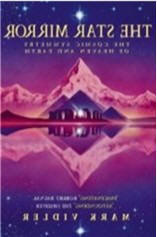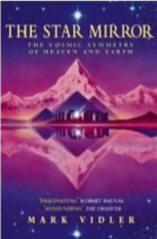



The Star Mirror
by Mark Vidler
Thorsons, 1998
HarperCollins; New Ed edition (September 20, 1999)
ISBN: 0722539045
Review by Dr. Colette M. Dowell © 1998
1. Pyramids, temples, earthen mounds, hill forts, tumuli, earth engravings and standing stones are known as sacred sites of our early ancestors. Ancient verbal, pictorial or text-written materials are known as mythological or folkloric tales and legends, petroglyphs, hieroglyphics, and sacred or biblical documents.
2. The league of the most brilliant stars in our night-time sky contain fewer than seventy stars and are categorized by their brilliance in terms of magnitude. Magnitude 1 basically consists of the first twenty most brilliant stars with magnitude 2 following with around fifty or so. The star Sirius is actually of a -1 magnitude due to its most brilliant factor. Magnitudes are classified numerically in order of the higher the magnitude-number, the less brilliant the star and generally more of them. There are possibly as many as three thousand stars classified as magnitude 5.
3. The ancient sky patterns of groups of stars are divided into 48 constellations. The constellation of Orion is well known for its significant role in archaeo-astronomy as being one of the major star groups which, align with strategically placed sacred sites, especially as relating to the Great Khufu Pyramid situated on the Giza Plateau in Egypt. In ancient Egyptian mythology the first Egyptian Gods to walk the earth were Osiris, the son of Nut (sky goddess), and Geb (Earth god), who was symbolized by the constellation of Orion, the brightest group of stars in the sky, with the greatest number of stars above the 2nd magnitude. His sister Isis, daughter of Nut and Geb, was symbolized by the first most brightest single night-time star Sirius, of the nearby Canis Major constellation.
4. The Great Khufu Pyramid has 11 angles of defining points derived from the external faces and apex of the pyramid along with interior shafts extending through the pyramid to the exterior faces. There is an invisible line called a meridian projected outside and above the pyramid which joins and aligns all of these angles.
5. In geometry, a triangle exhibiting two equal sides is known as an Isosceles triangle. An apex is the highest point of anything. Straight line alignment is a direct path without variation from one point to another.
Mark Vidler has uniquely combined all of the above elements to demonstrate how apexes of specific sacred sites, mountains and geographical sites create and direct a straight line alignment pointing to the most brilliant stars grouped in particular constellations following the sky path or meridians of the corresponding parallels on Earth. Vidler has also found a pattern of geometrical Isosceles triangles expressed both in the brilliant star patterns in the sky and our world's most highest peaks and most significant ancient sacred sites. When the celestial grid is superimposed on the Earth grid their geometric patterns correspond to each other as if they are reflecting one another or, in other words, mirroring each other. This is where Vidler deduces his Earth/Star mirror theory. He uses the straight line alignments of strategic points, angles and apexes on Earth, sacred sites and monuments, and follows their direction into the sky to see where their path may lead. He inevitably always finds the alignments point to the most brilliant stars in our night sky and that Isosceles triangles are displayed throughout the geometry expressed by both the layout of the surrounding stars, and the corresponding geography or ancient structures here on Earth. As above, so below.
With the use of a Sky Map computer program he has figured stellar coordinates and their relationship to specific terrestrial sites dating from 2450 BC up towards the 22nd century. He rigorously plots his coordinates and often works within 1/50th of a degree in error. Sometimes out of curiosity he rotates the stellar precession 30 degrees forward and still finds the reflective Star/Mirror relationship with constellations and sacred sites. He combines these findings with ancient myths, texts and murals, and presents the possibility that ancient peoples could predict celestial events of significant value which, are important to humankind to understand as they may be precursors to either great sociological spiritual awareness, or intense cataclysmic cycles.
He forecasts the stellar precession ahead to the year 2000 AD and further in time to show synchronistic stellar events and star epochs of particular constellations mentioned in ancient mythological texts. He focuses on Egypt and displays some ancient hieroglyphics and murals which, impressively show in detail, the actual alignments and celestial events to futuristically transpire due to precession. One example of the precession of stars and ancient Egyptian myths is that of Osiris (Orion), having lost his penis because a giant Nile perch swallowed it up, thus, he was unable to produce seed. However in the year 2080AD, the stars forming the dagger of Orion, being considered Osiris' phallus, become completely upright and erect enabling Osiris to produce seed again for the first time in over 10,000 years and spread his seed over the Valley of the Kings. The ancient Pharaohs foreseeing this astronomical event, and believing they were direct descendents of Osiris, prepared for their life after life by providing empty tombs and chambers buried underneath the sands of the Valley of the Kings. These empty Pharaoh's tombs have laid patiently in time waiting to catch the seed of Osiris in the Pharaoh's hopes of being reborn again as a star.
Vidler's studies are global and he shows the congruency between other cultures' legends, sacred sites and geographical aspects to stellar alignments and triangular geometry. Chinese pyramids, Mayan temples, North American Indian mounds and many other global sites reflect directly back to the sky's most brilliant stars. He shows how the ancient mound of Silbury Hill and the ancient ditch and stone circle of Avebury, located in the Wiltshire District of England, depicts an eye and that the star Eltanim, the most brilliant star of the constellation of Draco and known as the eye of the dragon, directly mirrors these sites during specific times of the stellar precession. He concludes that this is indeed a fact: that the Earth and sky mirror each other and the ancients knew this and left behind a form of straight line communication to the stars to help direct us to intellectualize and realize our cosmic stellar heritage.
His use of graphics of murals, hieroglyphics, pyramids, geometry, geography and star maps are beneficial to the reader and Vidler has gone to some extreme lengths to exhibit his theory by showing in detail important images of the Star/Mirror relationship. He shares quotes from ancient texts from various cultures and curiously they really seam to be prophetic in as much as conveying futuristic stellar events as well as expressing an understanding of the underlying internal triangular geometry. Vidler expresses much enthusiasm for his work and reveres it as one of the most extraordinary discoveries of our time.
Mark Vidler's work is highly controversial among some academia astronomers and archaeologists. Despite this somewhat hedge-fall, Vidler pursues his studies with great vigor and esteem and continues to exhibit and demonstrate some rather uncanny synchronistic Star/Mirror relationships.
In his closing 'The Last Word ', he states, "… a series of numerical equations that cannot readily be attributed to serendipity. None the less I am at a loss to describe this union between Heaven and Earth without a symbol for divinity appearing in the equation itself, and no such symbol exists in modern science. So perhaps the most successful way to communicate this enduring faith intellectually is, after all, to build a great mountain under a brilliant star."
![]()
An International Networking Educational Institute
Intellectual, Scientific and Philosophical Studies
Copyright © 1995, 2005, 2006
TABLE OF CONTENTS
The Official Website of
Dr. Robert M. Schoch, Ph.D.
Copyright © 2003, 2005, 2006
Dr. Robert M. Schoch & Dr. Colette M. Dowell
Angela Praxter - Professional Assistant